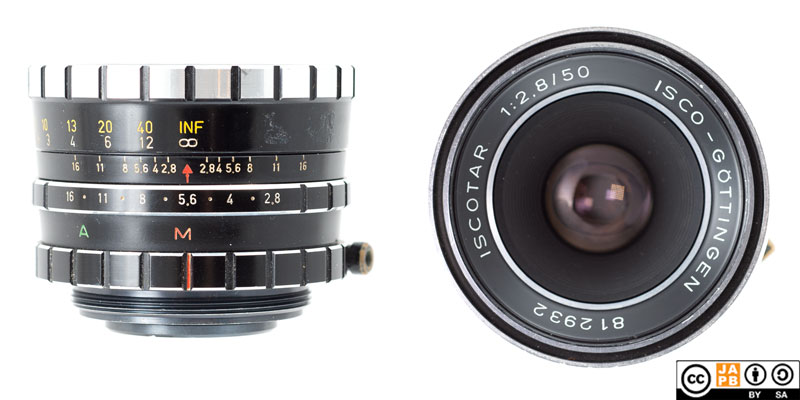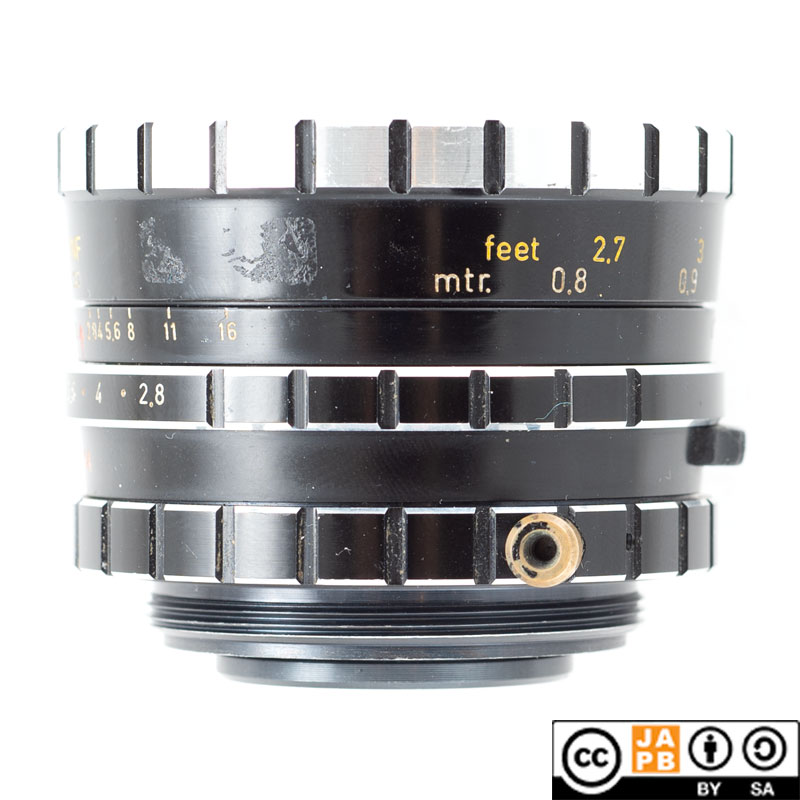Pekka Buttler, 07/2025

Specifications
The table below summarizes the lens’ key specifications (measurements based on pictured version of the lens):
| Brand: | ISCO-Göttingen | Lens name | Iscotar 1:2.8/50 |
| Focal length(s)1 | 50 mm | Angle-of-view2 | 47 ° |
| Maximum Aperture | f/2.8 | In Production | 1960s |
| Lens mount (this lens) | M42 (Edixa variant) | Other lens mounts | M42 (vanilla), Exakta |
| Length3 | 37,0 mm | Diameter4 | 57,0 mm |
| Filter ring diameter | 49 mm | Weight | 167 grams |
| Lens element count | 3 | Lens group count | 3 |
| Aperture blades (S/R/C)5 | 5 S | Focus throw | 270 ° |
| Minimum focusing distance (measured) | 73 cms | Maximum magnification (measured) | 1:11,7 |
| Has manual aperture ring | YES | Has Manual focus ring | YES |
| Aperture mechanism type | automatic/manual | Aperture click stops | 2.8-4-5.6-8-11-16 |
Further notes:
• This lens is a entry-level standard lens featuring a Cooke triplet.
• This sample is intended for use for use with Edixa M42 cameras (even though it is not explicitly mentioned on the lens’ name ring)
• Front to back, the lens has the following controls: Focus ring, aperture ring, auto/manual aperture control ring, cable release stop down port.
• The aperture ring has clicks at full stops.
• The filter threads rotate in step with the focusing ring.

Versions and variations
Besides one set of Iscotar lenses designed for the Exakta mount (with stop-down POD), the bulk of Iscotar lenses were manufactured for the M42 mount.
Among those M42 lenses some were designed for the vanilla M42 lens mount (Prakticas, Contax SLRs, etc.) while others were designed for the Edixa variant of the M42 mount (See the discussion about the Edixa variant here).
Besides the pictured cosmetically variant, there was also a later, all-black variant that is quite more common. Whether the cosmetically different variants share the same optical recipe is unclear, but likely.
Finally, there was a variant named the ISCO-Göttingen Edixa Iscotar 50/2.8 that was made for the Edixa Rex camera and its proprietary bayonet mount. That lens is not compatible with any
Adapting the ISCO Göttingen Iscotar 50 mm f/2.8
If you want to natively mount an M42 lens you need to find a functioning M42 mount film camera. Luckily that should be relatively easy as M42 bodies were produced in their millions and most of them lack features that are especially likely to have deteriorated to the point of making the entire camera inoperable. If your sample of this lens offers a switch to choose between auto- and manual aperture, I recommend using the lens on a body that is capable of stopping down the lens automatically and offers stop-down metering.
Adapting this lens to a mirrorless, full-frame digital camera is a breeze thanks to the lens having full manual controls (aperture ring, focus ring). You simply need a dumb adapter from M42 to your mirrorless system.
Due to the medium flange focal distance used by the M42 mount (45,46 mm), whether you can adapt this lens to dSLR/SLR mounts depends on which dSLR mount: Canon EF, Four Thirds, Minolta/Sony A and Pentax K can mount m42 lenses using a simple adapter ring. Nikon F on the other hand is not as problem-free, and – to retain anything near infinity focus – the adapter will necessitate corrective optics. In all cases, your camera will work only in stop-down metering.
History of ISCO Göttingen
ISCO Göttingen was one of many German optics companies that was prominent for a time, but was squeezed out of the market as competition became less forgiving. You can read more details in the ISCO Göttingen company profile.
Footnotes
- Focal length is (unless stated otherwise) given in absolute terms, and not in Full-frame equivalent. For an understanding of whether the lens is wide/tele, see ‘Angle-of-view’. ↩︎
- Picture angle is given in degrees (based on manufacturers’ specs) and concerns the diagonal picture angle. Rule of thumb:
> 90 ° ==> Ultra-wide-angle
70–90 ° ==> Wide-angle
50–70 ° ==> Moderate wide-angle
40–50 ° ==> ‘Standard’ or ‘normal’ lens
20–40 ° ==> Short tele lens
10-20 ° ==> Tele lens
5-10 ° ==> Long tele lens
< 5 ° ==> Ultra-tele lens ↩︎ - Length is given from the mount flange to the front of lens at infinity. ↩︎
- Diameter excludes protrusions such as rabbit ears or stop-down levers. ↩︎
- S=straight; R=rounded; C=(almost)circular at all apertures. ↩︎